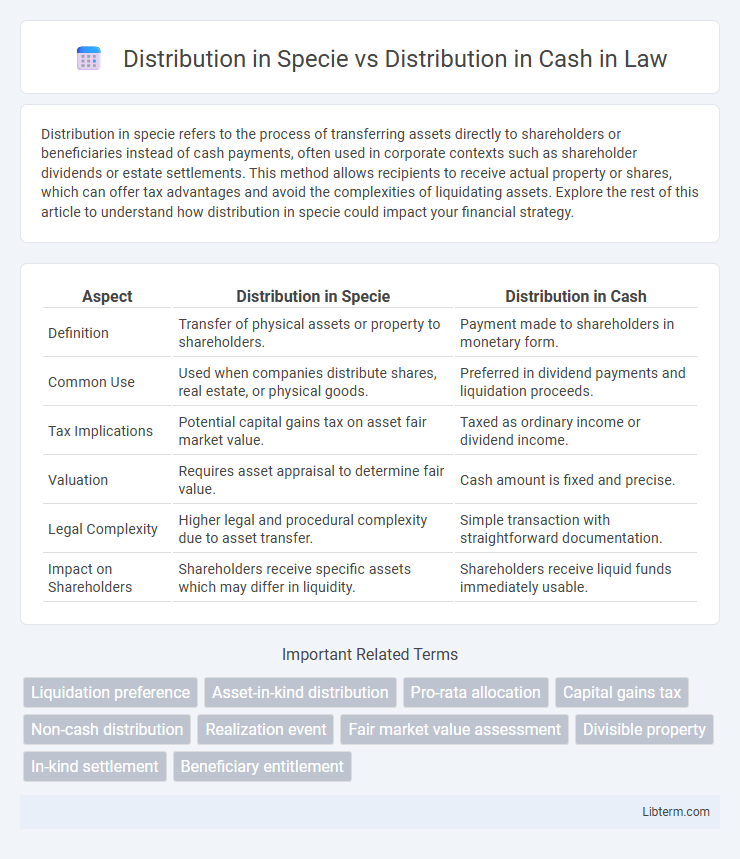Distribution in specie refers to the process of transferring assets directly to shareholders or beneficiaries instead of cash payments, often used in corporate contexts such as shareholder dividends or estate settlements. This method allows recipients to receive actual property or shares, which can offer tax advantages and avoid the complexities of liquidating assets. Explore the rest of this article to understand how distribution in specie could impact your financial strategy.
Table of Comparison
| Aspect | Distribution in Specie | Distribution in Cash |
|---|---|---|
| Definition | Transfer of physical assets or property to shareholders. | Payment made to shareholders in monetary form. |
| Common Use | Used when companies distribute shares, real estate, or physical goods. | Preferred in dividend payments and liquidation proceeds. |
| Tax Implications | Potential capital gains tax on asset fair market value. | Taxed as ordinary income or dividend income. |
| Valuation | Requires asset appraisal to determine fair value. | Cash amount is fixed and precise. |
| Legal Complexity | Higher legal and procedural complexity due to asset transfer. | Simple transaction with straightforward documentation. |
| Impact on Shareholders | Shareholders receive specific assets which may differ in liquidity. | Shareholders receive liquid funds immediately usable. |
Introduction to Distribution in Specie and Distribution in Cash
Distribution in specie refers to the transfer of assets to shareholders in their original form, such as stocks, property, or other tangible items, rather than converting them into cash. Distribution in cash involves the payment of dividends or returns to shareholders using liquid funds, typically generated from the company's revenues or asset sales. Understanding these two distribution methods is crucial for evaluating shareholder value and tax implications.
Defining Distribution in Specie
Distribution in specie refers to the transfer of assets to shareholders in their actual form, rather than converting those assets into cash before distribution. This method involves directly allocating physical assets such as stocks, property, or other tangible items, preserving the original value and ownership rights of the distributed assets. It contrasts with distribution in cash, where the company liquidates assets and distributes proceeds as monetary payments to shareholders.
Defining Distribution in Cash
Distribution in cash involves transferring actual currency or cash equivalents directly to shareholders as a return on investment, typically in the form of dividends or liquidation proceeds. Unlike distribution in specie, which involves transferring assets such as property or shares, cash distribution provides immediate liquidity to shareholders. This method is favored for its simplicity and ease of valuation compared to non-cash asset transfers.
Key Differences Between In Specie and Cash Distributions
Distribution in specie involves transferring assets such as shares, property, or securities directly to shareholders, preserving the specific nature of the asset. Distribution in cash provides shareholders with monetary payments representing the value of assets, offering liquidity and flexibility. Key differences include the impact on shareholder control, tax implications, and administrative complexity, with in specie distributions often requiring asset valuation and legal compliance, while cash distributions are straightforward and immediately usable.
Legal and Regulatory Framework
Distribution in specie involves transferring assets such as stocks or property directly to shareholders, subject to complex legal requirements under corporate and securities laws to ensure proper valuation and disclosure. Distribution in cash requires compliance with fiduciary duties and solvency tests dictated by jurisdiction-specific regulations to protect creditors and shareholders from improper depletion of company assets. Regulatory frameworks mandate transparency, accurate reporting, and adherence to tax implications for both distribution methods to align with shareholder rights and corporate governance standards.
Tax Implications of Each Distribution Method
Distribution in specie involves transferring assets like stocks or property directly to shareholders, which may trigger capital gains tax based on the fair market value of the distributed asset at the time of transfer. Distribution in cash typically results in taxable dividend income for shareholders, subject to ordinary income tax rates or qualified dividend rates depending on the holding period and type of dividend. Understanding the tax implications of each method is critical for effective tax planning and maximizing shareholder value.
Advantages and Disadvantages of Distribution in Specie
Distribution in specie offers the advantage of allowing shareholders to receive physical assets or securities directly, preserving the investment's value without forcing liquidation and potentially avoiding capital gains taxes. However, this method may introduce complexities in asset valuation, increase administrative costs, and pose challenges in transferring non-liquid assets. Unlike distribution in cash, which provides immediate liquidity, distribution in specie can result in difficulties for recipients needing to convert assets into cash.
Pros and Cons of Distribution in Cash
Distribution in cash offers immediate liquidity to shareholders, enabling quick access to funds without the need to sell assets. However, it may trigger tax liabilities for recipients, as cash distributions are often treated as taxable income or dividends. Compared to in specie distribution, cash distribution simplifies the process for the company but can strain corporate cash flow and limit reinvestment opportunities.
Practical Considerations for Businesses and Investors
Distribution in specie involves transferring assets such as stocks or property directly to shareholders, which can offer tax advantages and preserve cash flow for businesses. Distribution in cash, on the other hand, provides immediate liquidity to investors but may lead to cash depletion and potential tax consequences for the company. Businesses and investors must evaluate factors like asset liquidity, tax implications, shareholder preferences, and overall financial strategy when choosing between distribution in specie and distribution in cash.
Choosing the Right Distribution Method: Factors to Consider
Choosing the right distribution method between distribution in specie and distribution in cash depends on factors such as asset liquidity, tax implications, and shareholder preferences. Distribution in specie involves transferring actual assets to shareholders, which may be beneficial for retaining asset value and minimizing tax consequences but requires assets to be easily divisible and valued. Distribution in cash provides immediate liquidity and simplicity but may trigger capital gains taxes and requires sufficient cash reserves.
Distribution in Specie Infographic

 libterm.com
libterm.com